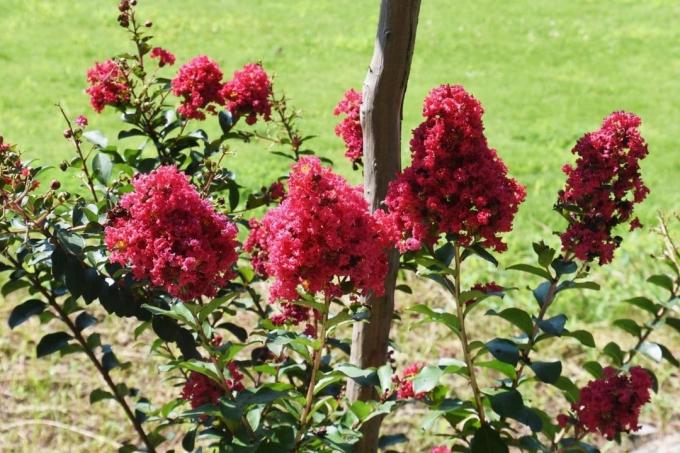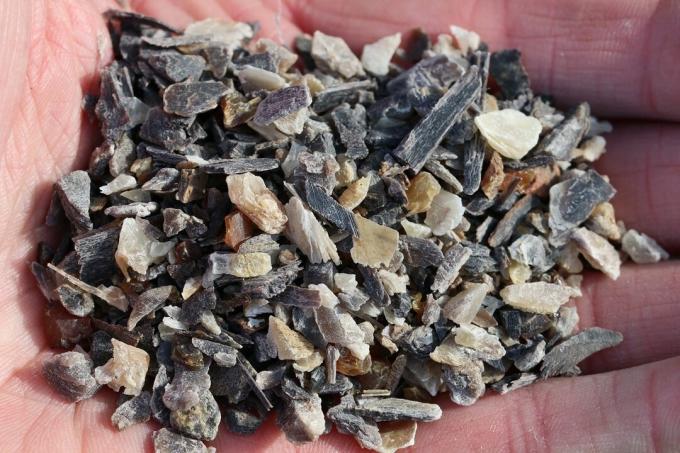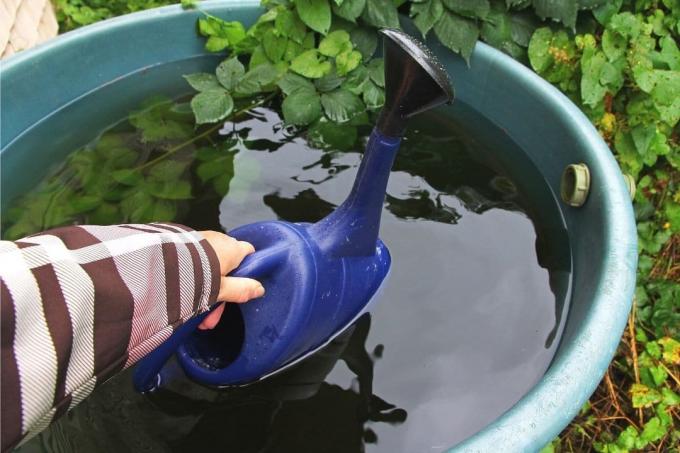
table of contents
- Site conditions
- plants
- to water
- Fertilize
- Cut
- Overwinter
- Multiply
- Diseases and pests
- frequently asked Questions
Profile and care information open +conclude -
- Flower color
- pink, red
- Location
- Sunny
- Heyday
- July, August, September, October
- Growth habit
- upright
- height
- up to 500 centimeters high
- Soil type
- loamy
- Soil moisture
- moderately moist
- PH value
- neutral, slightly acidic
- Limescale tolerance
- Calcium intolerant
- humus
- rich in humus
- Poisonous
- Yes
- Plant families
- Loosestrife, Lythraceae
- Plant species
- Container plants, ornamental trees
- Garden style
- Pot garden, winter garden, ornamental garden
The Indian lilac, a delightful flowering shrub, also known as crepe or curled myrtle, exudes Mediterranean flair in the garden or on the balcony. Its brightly colored flowers are actually reminiscent of crepe paper.
Site conditions
In terms of location, Indian lilac is quite demanding.

- sunny and warm
- without accumulating heat, but with as much sun as possible
- Facing south or west
- loose, well drained and nutrient-rich soil
- neutral to slightly acidic
- not too calcareous
For potted plants you can use normal garden soil with mature compost and coarse sand mix. Or you can use a structurally stable potted plant soil.
Tip: In years with few hours of sunshine, wet and cool weather, it can happen that the flower formation is significantly less or even completely absent.
plants
In the bed
Planting outdoors is only possible in areas with mild winter conditions. It is planted in spring so that Lagerstroemia indica can take root well before the first frost. You dig a correspondingly large planting hole and mix the excavated earth with some organic fertilizer, for example Horn shavings or mature compost.
Then you insert the Indian lilac so deep that the ball is approx. five to ten centimeters is covered with earth. In this way, the root area is well protected from frost. After installation, fill in with the remaining excavated earth, press the earth down and water well.

In the pot
Planting in pots is particularly recommended if you live in regions with very cold winters. Then Indian lilacs should not be left outdoors permanently anyway, but should be overwintered accordingly.
- Use a sufficiently large saucepan
- Capacity of about 50 liters
- and sufficient drainage holes
- Place the bucket on a wooden pallet or simple wooden slats
- Excess irrigation water can run off this way
- gravel drainage on the bottom of the pot
- fill in part of the substrate
- Insert the plant in the middle and deep enough
- Fill up with soil, press on soil and water
- Repot in fresh substrate after about two to three years
to water
The water supply is an important part of maintenance.
- Keep the soil constantly slightly moist
- high water requirement in long-lasting sunny and dry weather
- short-term drought is tolerated
- Not waterlogging
- Shedding of the buds during prolonged drought
- Water regularly for even soil moisture
It is best to water thoroughly and then let the top soil layer dry a maximum of one centimeter deep. Only then can it be poured again.

Tip: For watering you should only use rainwater or Use water with little lime.
Fertilize
This part of the maintenance can be neglected a bit. If fertilizer was already incorporated during planting, no additional doses are required this year. In the following years, too, a fertilizer application in the spring is completely sufficient. The Indian lilac can later supply itself with nutrients. Commercially available balcony plant fertilizer, which is administered weekly, is ideal for potted plants. From August onwards there is no more fertilization so that the young shoots can still mature well before frost.
Cut
Regular pruning has a significant influence on the formation of flowers, because this lilac blooms on young shoots this year. Due to the cut, Lagerstroemia indica forms many new shoots, which promises more abundant flowering. If there is no regular pruning, the flower formation will decrease more and more.
- best time after blooming in autumn
- Can also be cut in spring
- Strong pruning recommended in the first three to four years
- cut down to the stick
- in addition up to approx. Cut down 20 cm above the ground
- grows back more branched and bushier
- once the desired growth habit has been achieved, only cut harder to rejuvenate
- otherwise only old and dead or Remove inward growing and crossing shoots

Tip: It is advisable to disinfect the cutting tools used before and after the cut to prevent the transmission of pathogens.
Overwinter
In the bed
In our latitudes, Lagerstroemia indica is considered to be conditionally hardy. It tolerates temperatures of up to minus 15 degrees. In wine-growing regions with very mild winters, it could well overwinter outside, but not without protection, especially in the first few years:
- Cover the root area with fir twigs, leaves and / or straw
- Wrap above-ground parts of the plant with winter protection fleece
- Protection of the planting area in older specimens is usually sufficient
Out in the bucket
In rather warmer locations, potted plants can also hibernate outside with sufficient protection. A place in front of a warm house wall, which protects you from cold easterly winds, is ideal. It heats up during the day and gives off the heat to the plant at night. Direct sunlight should be avoided. The bucket is placed on a wooden pallet and wrapped with insulating materials such as fleece, bubble wrap or the like. The protection of the above-ground parts of the plant is the same as that in the bed.
Note: Care should not be neglected even in winter. Therefore, you should regularly check the substrate for moisture and, if necessary, water it moderately on frost-free days.
In the house
In most regions of Germany it is rather difficult for the Indian lilac to overwinter outdoors. It is usually much colder there. A frost-free wintering is essential.

- bring it into the house around November
- Winter quarters should be cool
- Temperatures of a maximum of ten degrees
- unheated garage or basement ideal
- not too warm
- Warmth stimulates the plant to sprout again at an early stage
- Water only moderately in winter
- Do not let the substrate dry out completely
From February the lilacs can move to a slightly warmer and lighter place. If the first new leaves appear, more can be poured and fertilized again. He may go outside as soon as night frosts are no longer to be expected. In the first few days you put it in a shady location and only then more and more in the sun.
Multiply
By sowing
Sowing is possible all year round, but the ideal time is in autumn. The seeds should be as fresh as possible and not older than six months, as they quickly lose their ability to germinate. A seed tray, high-quality seed substrate and appropriate seeds are required.
- Pre-soak seeds in lukewarm water for about 48 hours
- Fill the seed tray with substrate
- Spread seeds on it
- Cover minimally with soil and press down lightly
- moisturize and keep moist
- Use spray bottle
- Place the bowl in a bright, warm place (optimal germination temperature between 22 and 28 degrees)
- if the first cotyledons appear a little cooler (between 18 and 22 degrees)
- Prick out four to six weeks after germination
- Place seedlings one at a time in small pots
- do not damage fine roots

Tip: The growing medium should never dry out completely. Even a single drying out can prevent germination and ruin the success.
About cuttings
Propagation of cuttings is possible between June and mid-August. For this purpose, one uses blossomless, not lignified shoots or shoot sections, about finger-length. All but the top two or three sheets are removed. In order to minimize evaporation, the remaining can be halved.
- Fill small clay pots with nutrient-poor substrate
- insert one cutting per pot
- Pull transparent bags over pots
- Small plants should not touch the foil
- place in a bright, warm place
- without direct sunlight
- Remove the film from time to time to ventilate
- if new shoots appear, remove the film permanently
Diseases and pests
Wrong mildew
A common illness is mildew. A whitish-gray to brownish coating forms under the leaves. Yellowish or brown spots appear on the upper side of the leaves, which can also spread to the shoots and flowers. How to fight the fungal disease:
- remove all infected parts of the plant
- Disposal in household waste
- Prepare a spray solution from a packet of baking powder, two liters of water and 20 ml of rapeseed oil
- Spray the plant with it every two weeks
- Combination preparations containing copper are also helpful

Rust fungi
In addition to powdery mildew, rust fungi can also occur. They cause orange pustules on the leaves. The trade offers appropriate broad spectrum fungicides for treatment.
Aphids and spider mites
There are various home remedies that can be used to combat it. A rapeseed oil detergent solution consisting of 1 part rapeseed oil, a little washing up liquid and 4 parts water can help against spider mites. The treatment should be repeated after ten days.
Brews help against aphids Nettles, black tea or garlic and a milk-water mixture of 1 part milk and 2 parts water.
To combat both types of pests, you can use undiluted tea made from 2 tablespoons of fresh or dried basil and 1 liter of water. It is often enough to shower the plant vigorously, if that is possible.
frequently asked Questions
This term goes back to the fact that Lagerstroemia indica is a very popular ornamental wood in the United States and the hardy cultivars there often take the names of a tribe of Native Americans wear, e.g. B. 'Comanche', 'Osage' or 'Sioux'.
This can happen, for example, if you miss the right time to clear. But the underground shoots and buds are still well protected, and the plant can regenerate and rebuild.
Presumably it is because the Indian lilac has been cut back too much and therefore the flowering fails for a year.
All parts of the plant are considered to be slightly poisonous. Like other types of lilac, they also contain the glycoside syringin.
